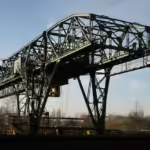During World War II, the German Railway Gantry Crane became a vital asset for the Nazi war effort. Used extensively in logistics and transport, these cranes played a crucial role in the movement of war materials, vehicles, and heavy equipment across the vast expanse of German-controlled territory. The ability to load, unload, and transport these materials quickly was essential in maintaining the momentum of military operations on the Eastern and Western fronts.
Design and Function of the German Railway Gantry Crane
The WW2 German Railway Gantry Crane was designed for the unique needs of railway transportation, which was the backbone of the Nazi war machine’s logistics. These cranes were typically mounted on railway cars, enabling them to be easily transported from one location to another, providing flexibility to military operations.
The cranes had a large, sturdy steel frame, capable of lifting extremely heavy loads, including tanks, artillery pieces, and large shipments of ammunition. These cranes were often powered by steam or diesel engines, allowing them to operate in various conditions. Their most notable feature was the ability to hoist and move heavy objects with great precision, making them indispensable in military depots and railway yards.
Strategic Use on the Eastern and Western Fronts
The ability to transport tanks, artillery, and military vehicles quickly from one point to another was vital for both the Eastern Front and Western Front during World War II. As the war escalated, the German Railway Gantry Crane proved to be an essential part of the logistics chain, facilitating the quick deployment of military equipment.
On the Eastern Front, the Nazi forces faced massive distances and difficult terrain, making the railway system a primary means of moving war materials. The German Railway Gantry Cranes played a key role in efficiently loading and unloading war machinery at railway hubs, ensuring that the troops received supplies and reinforcements as quickly as possible.
Similarly, on the Western Front, these cranes were critical for moving tanks and military vehicles across rail lines as the Allies made their way across Europe. The strategic positioning of the cranes at key transport hubs allowed the Germans to move their resources to where they were most needed, even under intense pressure from the advancing Allied forces.
The Role of Railway Infrastructure in the War
The German Railway Gantry Crane was part of a broader strategy that relied heavily on the railway system. Germany’s vast railway network was one of the most advanced in the world during the 1930s and 1940s, and its importance during the war cannot be overstated. Trains were responsible for moving everything from troops and supplies to heavy machinery and vehicles. Gantry cranes provided the essential capability to load and unload these supplies from trains efficiently.
The German military recognized the necessity of maintaining control over rail infrastructure, particularly as Allied forces targeted transport hubs in bombing campaigns. Railway stations, yards, and supply depots equipped with German Railway Gantry Cranes were among the highest-priority targets for the Allies.
Post-War Impact and Legacy
Following the end of World War II, the use of German Railway Gantry Cranes did not disappear entirely. In some cases, the cranes were repurposed for civilian use, particularly in the rebuilding of Europe’s shattered infrastructure. While the original military designs may have been modified, the cranes’ ability to move heavy loads remained relevant in the post-war industrial and transportation sectors.
The technology behind the German Railway Gantry Crane also influenced the development of modern-day container cranes, which are an essential part of today’s logistics and transportation systems. Although the original cranes have long since been replaced by more advanced systems, their influence can still be seen in the modern rail and logistics industries.
Conclusion
The WW2 German Railway Gantry Crane was a symbol of the logistical ingenuity that helped fuel the Nazi war machine. These cranes were indispensable for moving critical materials and machinery across vast distances, ensuring that the German military maintained its operational capacity. While they were eventually rendered obsolete by the changing dynamics of warfare and technology, their role during World War II highlighted the importance of efficient transport systems in modern warfare. The legacy of these cranes lives on in the sophisticated transportation infrastructure we rely on today.











